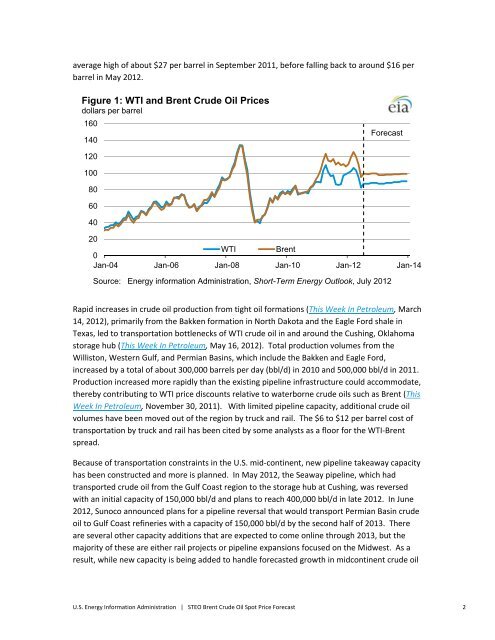Create successful ePaper yourself
Turn your PDF publications into a flip-book with our unique Google optimized e-Paper software.
average high of about $27 per barrel in September 2011, before falling back to around $16 per<br />
barrel in May 2012.<br />
Figure 1: WTI and <strong>Brent</strong> <strong>Crude</strong> <strong>Oil</strong> <strong>Price</strong>s<br />
dollars per barrel<br />
160<br />
140<br />
120<br />
100<br />
80<br />
60<br />
40<br />
<strong>Forecast</strong><br />
20<br />
0<br />
WTI <strong>Brent</strong><br />
Jan-04 Jan-06 Jan-08 Jan-10 Jan-12 Jan-14<br />
Source: Energy information Administration, Short-Term Energy Outlook, July 2012<br />
Rapid increases in crude oil production from tight oil formations (This Week In Petroleum, March<br />
14, 2012), primarily from the Bakken formation in North Dakota and the Eagle Ford shale in<br />
Texas, led to transportation bottlenecks of WTI crude oil in and around the Cushing, Oklahoma<br />
storage hub (This Week In Petroleum, May 16, 2012). Total production volumes from the<br />
Williston, Western Gulf, and Permian Basins, which include the Bakken and Eagle Ford,<br />
increased by a total of about 300,000 barrels per day (bbl/d) in 2010 and 500,000 bbl/d in 2011.<br />
Production increased more rapidly than the existing pipeline infrastructure could accommodate,<br />
thereby contributing to WTI price discounts relative to waterborne crude oils such as <strong>Brent</strong> (This<br />
Week In Petroleum, November 30, 2011). With limited pipeline capacity, additional crude oil<br />
volumes have been moved out of the region by truck and rail. The $6 to $12 per barrel cost of<br />
transportation by truck and rail has been cited by some analysts as a floor for the WTI‐<strong>Brent</strong><br />
spread.<br />
Because of transportation constraints in the U.S. mid‐continent, new pipeline takeaway capacity<br />
has been constructed and more is planned. In May 2012, the Seaway pipeline, which had<br />
transported crude oil from the Gulf Coast region to the storage hub at Cushing, was reversed<br />
with an initial capacity of 150,000 bbl/d and plans to reach 400,000 bbl/d in late 2012. In June<br />
2012, Sunoco announced plans for a pipeline reversal that would transport Permian Basin crude<br />
oil to Gulf Coast refineries with a capacity of 150,000 bbl/d by the second half of 2013. There<br />
are several other capacity additions that are expected to come online through 2013, but the<br />
majority of these are either rail projects or pipeline expansions focused on the Midwest. As a<br />
result, while new capacity is being added to handle forecasted growth in midcontinent crude oil<br />
U.S. Energy Information Administration | STEO <strong>Brent</strong> <strong>Crude</strong> <strong>Oil</strong> <strong>Spot</strong> <strong>Price</strong> <strong>Forecast</strong> 2

















